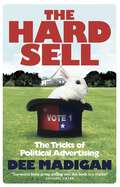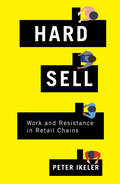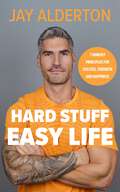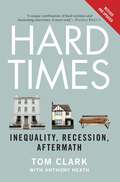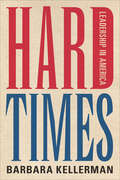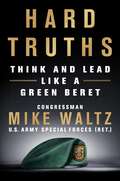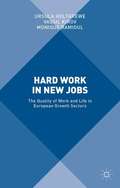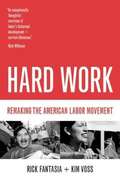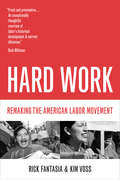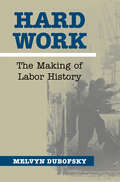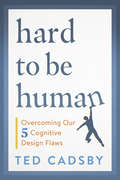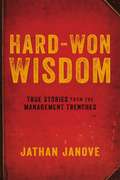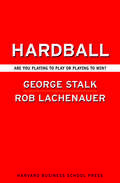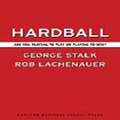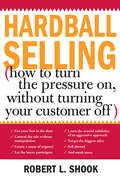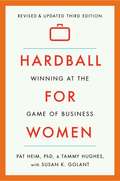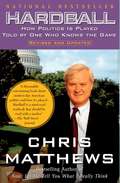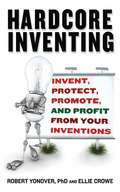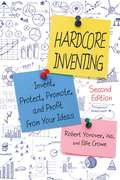- Table View
- List View
Hard Pressed in the Heartland
by Peter RachleffA social history of the labor movement and Hormel strike
Hard Rules: Dirty Money 1 (Dirty Money)
by Lisa Renee JonesWall Street meets Sons of Anarchy in Hard Rules, the smouldering, scorching first novel in the explosively sexy Dirty Money series from New York Times bestseller Lisa Renee Jones, author of the Inside Out series, which Kirkus Reviews calls: 'Angst-y, sexy contemporary romance with big emotional and financial stakes set against the backdrop of two dynamic families. Sure to leave readers desperate for the next installment'.How bad do you want it? The only member of the Brandon empire with a moral compass, Shane Brandon is ready to make his family's business legitimate. His ruthless brother Derek wants to keep Brandon Enterprises cemented in lies, deceit and corruption. But the harder Shane fights to pull the company back into the light, the darker he has to become. Then he meets Emily Stevens, a woman who not only stirs a voracious sexual need in him, but becomes the only thing anchoring him between good and evil. Emily is consumed by an all-encompassing passion for Shane. She trusts him. He trusts her, but therein lies the danger. Because Emily has a secret - the very thing that brought her to him in the first place - and that secret could destroy them both.Are you ready to play by the hard rules of the Brandon family empire? Look for the next enthralling novel in the Dirty Money series, Damage Control.
Hard Sell: The tricks of political advertising
by Dee MadiganIn The Hard Sell, creative director Dee Madigan uses her trademark humour and down-to-earth approach to unveil the world of political advertising. Drawing on real-life stories from her own recent Federal and State campaigns, she gives us fascinating industry insight into:• How political ads are designed to work;• Who are they designed to work on; • How we pay for them; • Why we make so many negative ads; • How personal is too personal; • How spin works, particularly in an election campaigns; • How to make messages cut through the cynicism; • How politicians use journos who use politicians who use journos; • The gendered nature of it all; • And finally, what happens when it all turns to sh*t!Dee is candid about the tricks of the trade and the lessons that can be learnt.
Hard Sell: Work and Resistance in Retail Chains
by Peter IkelerAlong with fast-food workers, retail workers are capturing the attention of the public and the media with the Fight for $15. Like fast-food workers, retail workers are underpaid, and fewer than 5 percent of them belong to unions. In Hard Sell, Peter Ikeler traces the low-wage, largely nonunion character of U.S. retail through the history and ultimate failure of twentieth-century retail unionism. He asks pivotal questions about twenty-first-century capitalism: Does the nature of retail work make collective action unlikely? Can working conditions improve in the absence of a union? Is worker consciousness changing in ways that might encourage or further inhibit organizing? Ikeler conducted interviews at New York City locations of two iconic department stores--Macy's and Target. Much of the book's narrative unfolds from the perspectives of these workers in America's most unequal city.When he speaks to workers, Ikeler finds that the Macy's organization displays an adversarial relationship between workers and managers and that Target is infused with a "teamwork" message that enfolds both parties. Macy's workers identify more with their jobs and are more opposed to management, yet Target workers show greater solidarity. Both groups, however, are largely unhappy with the pay and precariousness of their jobs. Combined with workplace-generated feelings of unity and resistance, these grievances provide promising inroads to organizing that could help take the struggle against inequality beyond symbolic action to real economic power.
Hard Stuff, Easy Life: 7 Mindset Principles for Success, Strength and Happiness
by Jay AldertonIN A WORLD WHERE COMFORT AND CONVENIENCE OFTEN RULE, DISCOVER THE 7 MINDSET PRINCIPLES THAT ARE THE SECRET TO A FULFILLING LIFE ----EVERY TRANSFORMATION STARTS FROM THE NECK UPAre you tired of never getting what you want?Is convenience preventing you from achieving your goals?Do you crave an easier, more meaningful life?An ex-military and a transformation coach, Jay Alderton reveals the game-changing truth: the secret to an easy life is conquering the hard stuff, and the hard stuff is all in your head. Because every great transformation starts from the neck up, all you need to do is learn how to crack the mindset code to make the hard stuff very easy.By breaking down the seven key mindset principles for success, strength and happiness, Hard Stuff, Easy Life will equip you with the tools to overcome any obstacle . . . 1. Happiness Is an Inside Job2. Make Peace with Your Past3. Stay True to Yourself4. Get Over What Other People Think5. Focus on the Big Picture6. Embrace Obstacles7. Stay PresentOne of the most valuable and frequently overlooked lessons of all is that about staying present in the moment. This is how you not only build a life you want, but live it to the fullest, too.Whether you're aiming to conquer personal goals, get rich and successful, or thrive in your personal life, this book is your compass and guide towards what can be your easy life of fulfilment, abundance, and jaw-dropping achievements. It’s your new revolutionary guide that will transform your life, starting from the neck up.CRACK THE MINDSET CODE AND START LIVING YOUR BEST LIFE
Hard Times
by Anthony Heath Tom Clark2008 was a watershed year for global finance. The banking system was eventually pulled back from the brink, but the world was saddled with the worst slump since the 1930s Depression, and millions were left unemployed. While numerous books have addressed the financial crisis, very little has been written about its social consequences. Journalist Tom Clark draws on the research of a transatlantic team led by Professors Anthony Heath and Robert D. Putnam to determine the great recession's toll on individuals, families, and community bonds in the United States and the United Kingdom. The ubiquitous metaphor of the crisis has been an all-encompassing "financial storm," but Clark argues that the data tracks the narrow path of a tornado-destroying some neighborhoods while leaving others largely untouched. In our vastly unequal societies, disproportionate suffering is being meted out to the poor-and the book's new analysis suggests that the scars left by unemployment and poverty will linger long after the economy recovers. Politicians on both sides of the Atlantic have shown more interest in exploiting the divisions of opinion ushered in by the slump than in grappling with these problems. But this hard-hitting analysis provides a wake-up call that all should heed. "
Hard Times: Leadership in America
by Barbara KellermanLeadership has never played a more prominent role in America's national discourse, and yet our opinions of leaders are at all-time lows. Private sector leaders are widely seen as greedy to the point of being corrupt. Public sector leaders are viewed as incompetent to the point of being inept. And, levels of trust in government have plummeted. As the title of this book conveys, leaders in America are experiencing hard times. Barbara Kellerman argues that we focus on leaders, and even on followers, while ignoring an essential element of leadership: context. This book is a corrective. It enables leaders to track the terrain that they must navigate in order to create change. Rather than a handy-dandy manual on what to do and how to do it, Hard Times is structured as a checklist. Twenty-four brief sections cover key aspects of the American landscape. They trace evolutions and revolutions that have revised our norms, transformed our populations and institutions, and shifted our culture. Kellerman's crash course on context reveals how significant it is to leadership. Clearer still is the fact that leadership is more difficult than it has ever been. It is context that explains why leadership is so fraught with frustration. And, it is context that makes evident why leadership will be better exercised if it is better understood. Calling out patterns that emerge from the checklist, Kellerman challenges leaders to do better. This fascinating read will change the way that all of us think about leadership, while compelling us to consider what it means for our future.
Hard Truths: Think and Lead Like a Green Beret
by Congressman Mike WaltzCongressman and retired Green Beret Mike Waltz shares how the mindset he honed in military service can help anyone—in politics, in business or in life—conquer everyday challenges.Up in the mountains of Afghanistan, one of Mike Waltz's snipers watched through his scope as a young boy acted as a spotter for the Taliban mortars attacking a Green Beret position. The sniper requested permission to fire. Waltz refused, insisting on restraint. The child was spared, and the position was held. Later that same day, Waltz visited a nearby Afghan village and discovered the Taliban had hanged a boy in front of his family—because the child wasn't willing to fight for them.Restraint is a trait common to Green Berets, but rare on the battlefield—and even rarer in today's national political discourse.Now, Mike Waltz is a retired Colonel and a U.S. Representative from Florida, the first Green Beret ever to be elected to Congress. After twenty-seven years in the Army, nearly all of them in the elite Special Forces where he fought America's enemies around the world, he has developed a perspective distinct from most—probably all—of his colleagues in politics today.
Hard Work in New Jobs
by Ursula Holtgrewe Vassil Kirov Monique RamioulThis book investigates hard work and new and expanding jobs in Europe. The interrelationship between the labour market and welfare regimes, and quality of work and life is played out at many levels: the institutional; the organizational level of the company and its customers or clients; and the level of everyday life at the workplace and beyond it.
Hard Work: Remaking the American Labor Movement
by Rick Fantasia Kim VossThis concise overview of the labor movement in the United States focuses on why American workers have failed to develop the powerful unions that exist in other industrialized countries. Packed with valuable analysis and information, Hard Work explores historical perspectives, examines social and political policies, and brings us inside today's unions, providing an excellent introduction to labor in America.
Hard Work: Remaking the American Labor Movement
by Rick Fantasia Kim VossThis concise overview of the labor movement in the United States focuses on why American workers have failed to develop the powerful unions that exist in other industrialized countries. Packed with valuable analysis and information, Hard Work explores historical perspectives, examines social and political policies, and brings us inside today's unions, providing an excellent introduction to labor in America. Hard Work begins with a comparison of the very different conditions that prevail for labor in the United States and in Europe. What emerges is a picture of an American labor movement forced to operate on terrain shaped by powerful corporations, a weak state, and an inhospitable judicial system. What also emerges is a picture of an American worker that has virtually disappeared from the American social imagination. Recently, however, the authors find that a new kind of unionism--one that more closely resembles a social movement--has begun to develop from the shell of the old labor movement. Looking at the cities of Los Angeles and Las Vegas they point to new practices that are being developed by innovative unions to fight corporate domination, practices that may well signal a revival of unionism and the emergence of a new social imagination in the United States.
Hard Work: The Making of Labor History (Working Class in American History)
by Melvyn DubofskyA career-spanning collection of writings by the legendary labor historian One of American labor history's most prominent scholars, Melvyn Dubofsky curated an accessible style and historical reach that have long marked his work as required reading for students and scholars. This collection juxtaposes Dubofsky's early writings with scholarship from the 1990s. Selections include work on western working-class radicalism, U.S. labor history in transnational and comparative settings, and the impact of technological change on American worker’s movements. Throughout, the writings provide an invaluable eyewitness perspective on the academic and political climate of the 1960s and 1970s while tracing the development of labor history as a discipline. An exploration of important themes in labor history, Hard Work combines essential scholarship with the story of how past and present interact in the work of historians.
Hard to Be Human: Overcoming Our Five Cognitive Design Flaws
by Ted CadsbyPowerful strategies to combat the design flaws of the human brain that make life in the twenty-first century unreasonably difficult.If other animals could study us the way we study them, they would be puzzled by our unique ability to inflict misery on ourselves. We expend a lot of energy replaying past anguish, anticipating future distress, and stewing in self-righteous anger. Other animals would call us out for being oddly paradoxical creatures who long to be happy but who are the source of their own suffering, We worry about things we have no control over. We complain about not being understood while casting a critical eye on others. We stubbornly defend our beliefs despite contradictory evidence. Complicating all of this is our struggle to adapt to a complex world that we created. who struggle to adapt to a confusing world that we ourselves created.In our defence, we haven’t yet mastered our neuron-packed brains, whose incredible complexity evolved over millennia in a very different world than today’s. The result of this evolutionary journey? Five design features that often morph into design flaws in need of fixing.Hard to Be Human corrals the best insights from psychology, neuroscience, physics, and philosophy to reveal powerful strategies for the five big battles we each face in the war with our misguided, misbehaving selves. Tapping into deeply personal stories to ground the concepts in real life, Cadsby reveals how we can overcome our design flaws to be smarter, happier, and better adapted to the complexities of life in the twenty-first century.
Hard-Won Wisdom: True Stories from the Management Trenches
by Jathan JanoveFrom dealing with underperformers to fighting off lawsuits, employee problems are the bane of a manager's existence. So what do most do? Ignore them!And that's a recipe for more problems. Written by a seasoned HR expert and employment attorney, Hard-Won Wisdom takes you inside the messy reality of situations gone wrong, including:A joking comment taken as a commandAn email exchange that escalates ridiculously out of controlA request for confidentiality that backfires in a big wayThe right employee...fired the wrong wayThe wrong employee...hired the right wayThese sometimes funny, always cautionary tales reinforce crucial lessons for managers. From failing to give feedback and withholding key information to exercising poor judgment and making faulty assumptions, every story highlights the role management plays in exacerbating (or easing) trouble.And each story suggests simple strategies to turn the situation around. The memorable lessons help managers motivate underachievers, defuse angry employees, discipline without inviting legal action--and handle every tricky-people issue they simply can't avoid.
Hardball
by George Stalk John Butman Rob LachenauerGreat companies stumble and fall when they lose it. Highfliers crash when a competitor notices they don't have it. Start-ups shut down if they can't develop it. "It" is a strategy so powerful and an execution-driven mindset so relentless that companies use it to gain more than just competitive advantage--they achieve an industry dominance that is virtually unassailable and that competitors often try to explain away as unfair. In their "hardball manifesto," authors George Stalk and Rob Lachenauer of the leading strategy consulting firm The Boston Consulting Group show how hardball competitors can build or maintain an enviable competitive edge by pursuing one or more of the classic "hardball strategies": unleash massive and overwhelming force, exploit anomalies, devastate profit sanctuaries, raise competitors' costs, and break compromises.Based on 25 years of experience advising and observing a range of companies, the authors argue that hardball competitors can gain extreme competitive advantage--neutralizing, marginalizing, or even destroying competitors--without violating their contracts with customers or employees and without breaking the rules. A clear-eyed paean to the timeless strategies that have driven the world's winning companies, Hardball Strategy redefines and reinterprets the meaning of competition for a new generation of business players. George Stalk and Rob Lachenauer are directors of The Boston Consulting Group. Stalk is the author of Competing Against Time, the classic work on time-based competition.
Hardball Selling
by Robert ShookStraightforward secrets and strategies for salespeople who want to join the winning top 5 percent of the sales force Get your foot in the door Control the sale without manipulation Create a sense of urgency Let the buyer participate Learn the crucial subtleties of an aggressive approach Target the biggest sales Sell abroadAnd much moreFor many companies, 20 percent of their sales force generates 80 percent of their sales volume. In this hands-on guide, Robert L. Shook, a master salesman, teaches the high-pressure strategies that mean the difference between a super seller and a salesperson. The methods spelled out in this book describe what it takes to be in the elite 5 percent.In Hardball Selling, Shook inspires all salespeople to dare to be different and master hard selling without browbeating or offending customers. Shook spent 17 years in the trenches perfecting his successful strategies. Using the four basic principles of hardball selling, he guides you through all the steps, from getting past the "gatekeeper" to the single-minded tactics necessary to close a sale."Shook's Hardball Selling is provocative and controversial--and filled with wonderful selling tips. I highly recommend it to every salesperson."--Martin D. Shafiroff, the world's No. 1 stockbroker
Hardball for Women
by Susan K. Golant Pat HeimIn Hardball for Women, Pat Heim shows women how to break patterns of behavior that have put them at a disadvantage in the business world of men. Whether the arena is a law firm, a medical group, a corporation, or any other work environment, Hardball for Women decodes the male business culture and gives readers strategies on how to use its rules to get ahead--and stay ahead. Readers will learn to: Be assertive without being obnoxious Display confidence Engage in smart self-promotion Lead both men and women--and recognize the differences between them Use "power talk" language to your advantage
Hardball for Women
by Susan K. Golant Pat Heim Tammy HughesThe bestselling guide fully updated for the post-Lean In era For nearly two decades, Hardball for Women has shown women how to get ahead in the business world. Whether the arena is a law firm, a medical group, a tech company, or any other work environment, Hardball for Women decodes male business culture and shows women how to break patterns of behavior that put them at a disadvantage. It explains how to get results when you "lean in" without being thrown off balance. Illustrated with real-life examples Hardball for Women teaches women how to:Successfully navigate middle management to become a leader in your fieldBe assertive without being obnoxiousDisplay confidenceEngage in smart self-promotionLead both men and women--and recognize the differences between themUse "power talk" language to your advantage
Hardball for Women: Winning at the Game of Business
by Susan K. Golant Pat HeimFrom the book: "The majority of women in the business world today are oblivious to the fact that they are standing on a playing field while a game is being played around them. Until you realize that business is conducted as a sport, you'll never move ahead and you'll never win" --PAT HEIM Exploring from the ground up how boys and girls are taught to behave, author Pat Heim uses her extensive experience in the business world and a wide variety of research to show you how your behavior is interpreted to determine whether you are strong or weak, clear or vague, ambitious or passive, and, ultimately, promotable or not. Then she shows you how to understand the game of business and how to build on that understanding to succeed in your career. You'll master the following skills: How to lead men, and how to lead women. How to turn criticism and praise to your advantage. How to display confidence and power even when you feel frightened and powerless. How to be on either end of an attack during a business meeting and still remain cordial later. How to offer help so you're not seen as obstructionist. How to take risks. (continued from front flap) How to distinguish between the male and female version of a "team player." How to work with people you don't like. How to hide your vulnerability. The goal of Hardball for Women is to let you act rather than react, to help you see the rules that men play by and use them to meet your own goals, to make you feel comfortable, even exhilarated, with playing the competitive game. This book will give you the strategies that have worked to bring success in business.
Hardball: How Politics Is Played Told By One Who Knows The Game
by Chris MatthewsHow politics is played by one who knows the game...Chris Matthews has spent a quarter century on the playing field of American politics—from right-hand man of Speaker of the House Tip O'Neill to host of NBC's highest rated cable talk show Hardball. In this revised and updated edition of his political classic, he offers fascinating new stories of raw ambition, brutal rivalry, and exquisite seduction and reveals the inside rules that govern the game of power.
Hardcore Inventing: Invent, Protect, Promote, and Profit From Your Ideas
by Robert N. Yonover Ellie CroweBased on the author's experience in the world of inventing and promotion, Hardcore Inventing offers the kind of advice you can only learn from experience: how to developing an idea into an invention, how to build a prototype for show, how to safeguard intellectual property, how to market both strategically and and in "guerilla" mode, how find investors, and much more. And all of that is based on his IP 3 "Tacitical Method" which breaks everything down to Invent, Protect, Promote, and Profit.
Hardcore Inventing: Invent, Protect, Promote, and Profit from Your Ideas
by Ellie Crowe Robert YonoverYou've come up with a great solution to a persistent problem-an invention that will help thousands of people. But what do you have to do to turn it into a reality? Robert Yonover uses his experiences from the world of inventing and promotion to take you through the invention process step-by-step. Learn how to:Find the problem you can solveBuild a show prototypeCreate an attention-grabbing and memorable nameFind investorsSafeguard your intellectual propertyNavigate critical crossroadsLicense and market your inventionFrom your initial idea through a captivating proposal, Hardcore Inventing is an easy-to-use, informational, and inspirational guide on how to turn your idea into a success.
Harder Than I Thought
by Robert D. Austin Richard L. Nolan Shannon O'DonnellMeet Jim Barton, new CEO of Santa Monica Aerospace. Jim's job won't be easy: the company's hemorrhaging cash, struggling to regain investors' trust after an accounting scandal, and striving to transform its military and manufacturing culture to become a global aerospace integrator.Jim isn't real: Harder Than I Thought is a novel. But his story--developed in consultation with seasoned, actual CEOs--contains crucial lessons for all chief executives. Walk in Jim's shoes to engage in challenges that include:1. Formulating and executing strategy2. Managing financial and labor crises3. Fostering a culture of innovation and continuous transformation4. Forging global partnerships5. Making ethical choices in an increasingly transparent environmentAs events in each chapter push Barton to the edge of his abilities, he seeks counsel from a panel of expert advisers. These collaborative reflections invite you to apply the lessons from this story to your own situation.Experts agree that many twentieth-century leadership practices are inadequate to the stormy twenty-first-century present. This engaging and provocative book equips you with the insights you'll need to rise with the occasion of a rapidly shifting business landscape.
Hardheaded & Softhearted: Lessons from the Boardroom to the Break Room (Hardheaded And Softhearted Ser.)
by Rick Belluzzo Krish DhanamThe former Microsoft CEO and an executive coach trained by Zig Ziglar share their business philosophy of balancing IQ with emotional intelligence.Rick Belluzzo and Krish Dhanam offer their “Lessons from the Boardroom to the Break Room” based on their extensive experience with companies such as Microsoft, Hewlett Packard, Quantum, and the Zig Ziglar Corporation. This little book captures their wisdom in capsule form, designed to guide readers along the path to a point where IQ meets EQ and quality of life results. When head and heart, skill and will, and strategic formula and emotional foundation merge, leaders can excel professionally and personally, and organizational cultures become more dynamic and productive.“Running a successful business requires IQ and EQ (emotional intelligence) because decisions affect people . . . With a business world where change is the new normal, you need EQ and IQ to prosper.” —The Dallas Morning News“Rick Belluzzo and Krish Dhanam are living embodiments of their brand of leadership philosophy . . . [they] believe it is imperative that executives not only be able to steer their companies through these times of trouble, but also effectively communicate the need to change and their vision for doing so to employees.” —Trinidad & Tobago Guardian


